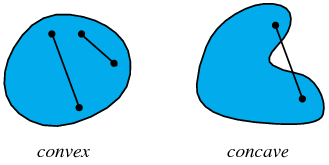Linear Inequalities & Linear Programming¶
Inequalities¶
Inequalities are of four types:
| Inequalities | Symbol |
|---|---|
| Greater than | \(>\) |
| Less than | \(<\) |
| Greater than or equal to | \(\ge\) |
| Less than or equal to | \(\le\) |
Linear Inequalities¶
Generally a linear inequality in two variables \(x\) & \(y\) can be one of the following four forms:
- \(ax + by < c\)
- \(ax+ by \le c\)
- \(ax + by > c\)
- \(ax + by \ge c\)
where \(a\), \(b\) & \(c\) are constants also \(a\), \(b\) can not zero simultaneously.
Some Important Results Related To Linear Inequality In Two Variables:¶
- \(ax + by = c\) is called associated or corresponding equation of any of the above four linear inequalities.
- Every inequality divides a plane into two half planes.
- A vertical line divides the plane into left and right half planes.
- A non-vertical line divides the plane in to upper and lower half planes.
- If an inequality involves symbols \(>\) or \(<\) the half plane is open.
- If an equality involves symbols \(\ge\) or \(\le\) half plane is closed.
- A point of a solution region where two of its boundary lines intersect is called corner point or vertex.
Procedure for Graphing a Linear Inequality in Two Variables¶
- Graph the corresponding equation \(ax + by = c\) used a dashed line when symbols \(>\) or \(<\) involves, and a solid line when the symbols \(\ge\) or \(\le\) involves.
- The solution set is the half plane on one side of the boundary line. To determine which side, choose a test point (any point in the plane but not on the line) and check to see if the coordinates of the point satisfy the given inequality.
Linear Programming¶
Linear programming is a branch of mathematics that deals with an important class of constrained optimization problems.
Some terms related to linear programming;¶
- Problem constraints: The system of linear inequalities involved in the problem concerned is called problem constraints.
- Decision variables: Non-negative constraints are called decision variables.
- Feasible region: A restricted region under certain constraints is called the feasible region.
- Feasible solution: Each point of the feasible region is called feasible solution.
- Feasible solution set: The set of all feasible solutions of a system of linear inequalities is called feasible solution set.
- Convex region If the line joining any two points of a region lies entirely with in the region. then the region is called convex.

- Objective function A function which is to be maximized or minimized but not both is called objective function.
- Optimal solution The feasible solution which maximizes or minimizes the objective function is called optimal solution.
Procedure for Determining Optimal Solution:¶
- Graph the solution set of linear inequality constraints to determine the feasible region.
-
Find the corner points of the region.
-
Evaluate the objective function at each corner point to find the optimal solution.
To be Remembered
- There are infinite many feasible solutions in the feasible region.
- The intersection point of two boundary lines is a corner point only if it is feasible.
- If a linear program has an optimal solution, it must occur at a corner point of the feasibility region.